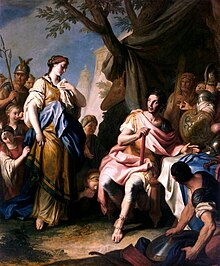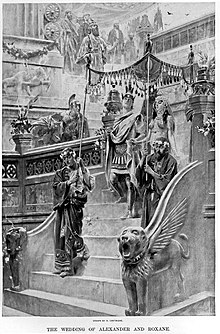Roxana
You can help expand this article with text translated from the corresponding article in German. (April 2017) Click [show] for important translation instructions.
|
| Roxana | |
|---|---|
Macedon, Ancient Greece | |
| Spouse | Alexander the Great |
| Issue | Alexander IV |
| Father | Oxyartes |
| Religion | Zoroastrianism |
Roxana (dead 310 BC,


Biography
Roxana was born as the daughter of a Bactrian nobleman named
They were eventually defeated by Alexander, who attended a celebration,[6] and reportedly fell in love with Roxana on sight.[7] The location of the celebration took place is disputed,[6] possibly in the Sogdian Rock or another fortress of Chorienes (also called Sisimithres by Quintus Rufus Curtius), but according to the Metz Epitome it was in the house of Chorienes in which Roxana was introduced to Alexander as the daughter of Oxyartes.[8][6] Curtius apparently misrepresented Roxana as a daughter of Chorienes.[6] Arrian states that Oxyartes surrendered to Alexander when he became aware of the good reception Alexander awarded his daughter Roxana.[6] A.B. Bosworth mentions the possibility of Roxana being captured at the Sogdian Rock, but that the two married at the fortress of Chorienes.[6] The marriage was in 327 BC, and according to the majority of the sources it was in the Macedonian rite rather than the Persian.[9]
Alexander married Roxana despite opposition from his companions[10][9] who would have preferred a Macedonian or other Greek to become queen.[11] However, the marriage was also politically advantageous as it made the Sogdian army more loyal towards Alexander and less rebellious after their defeat.[12] Alexander thereafter made an expedition into India and while there he appointed Oxyartes as the governor of the Hindu Kush region adjoining India.[1] Roxana accompanied Alexander into India, where her first son died at or soon after birth near the banks of the Acesines River [13] in November 326 BC.
When Alexander returned to Susa in spring 324 BC, he promoted a brother of Roxana to the elite cavalry.
After Alexander's sudden death at Babylon in 323 BC, Roxana is believed to have murdered Stateira. According to Plutarch, she also had Stateira's sister, Drypetis, murdered with the consent of Perdiccas.[14] Roxana was pregnant, which caused some discussions between Alexander's loyalists around Perdiccas[15] and Ptolemy[16] who suggested waiting to see if Alexander's posthumous child was a son and naming either a caretaker regent or a council to govern on his behalf, and the Macedonian soldiers who opposed a so-called persianization of the Macedonian court.[15]
For the Macedonian succession a temporary compromise was found as
Legacy
- Asteroid 317 Roxane is named in her honor.[24]
- At the Acropolis, there were found inscriptions of offerings Roxana shall have dedicated as Alexander's wife to Athena.[25]
- Lucian describes a painting of Roxana's marriage to Alexander by the Greek painter Echion (also known as Aetion) which won the painter the consent of the Olympic Hellanodike Proxenidas to marry his daughter.[25]
- In one of the versions of the Alexander Romances, Darius III is her father and dying gives his consent to the marriage in which she wears the royal jewelry Alexander had asked for at his mother Olympias. The marriage takes then place in Darius' palace.[25]
See also
- Mozartplanned to write
- Ancient history of Afghanistan
- Balkh
- Roshanak
- Global Royal intermarriage
References
- ^ Encyclopedia Iranica. Retrieved 23 November 2021.
- ^
- Ahmed, S. Z. (2004). Chaghatai: the Fabulous Cities and People of the Silk Road. West Conshokoken: Infinity Publishing. p. 61.
- Strachan, Edward; Bolton, Roy (2008). Russia and Europe in the Nineteenth Century. London: Sphinx Fine Art. p. 87. ISBN 978-1-907200-02-1.
- Ramirez-Faria, Carlos (2007). Concise Encyclopedia of World History. New Delhi: Atlantic Publishers & Distributors. p. 450. ISBN 978-81-269-0775-5.
- ISSN 2157-9687.
- ^
- "Roxana". Encyclopædia Britannica. 6 November 2019. Retrieved 10 October 2019.
- Schmitt, Rüdiger (20 July 2002). "OXYARTES". Encyclopædia Iranica. Retrieved 10 October 2019.
- Strabo 11.11.4.
- Rawlinson, Hugh G. (1912). Bactria, the History of a Forgotten Empire.[page needed]
- ^ a b Badian 2015.
- ^ S2CID 161365503.
- ^ Horn & Spencer 2012, p. 40.
- ^ Chaumont, Marie-Louise. "Welcome to Encyclopaedia Iranica". Encyclopædia Iranica. Retrieved 11 February 2022.
- ^ JSTOR 1561949.
- ^ Young, Andrew (2014),p.145
- JSTOR 2707202.
- ISBN 978-1-59416-197-1.
- ^ Metz Epitome 70
- ^ Plutarch. Alex. 77.4
- ^ ISBN 978-1-4443-3962-8.
- ^ Anson, Edward M. (14 July 2014), pp.16–17
- ^ Anson, Edward M. (14 July 2014), pp.20–21
- ^ Anson, Edward M. (14 July 2014), p.106
- ^ a b Anson, Edward M. (14 July 2014), p.116
- ^ .
- ^ Thirlwall, Connop (1840). A History of Greece. Longmans. p. 318.
- ^ Thirlwall, Connop (1840), p.319
- ^ Anson, Edward M. (14 July 2014), p.149
- ISBN 978-3-540-00238-3.
- ^ JSTOR 25167339.
Sources
- Badian, Ernst (2015). "RHOXANE ii. ALEXANDER'S WIFE". Encyclopædia Iranica. Retrieved 11 March 2021.
- ISBN 978-0-14-139076-5.
- Perseus Project. Retrieved 6 December 2011.
- Plutarch (1936). Babbitt, Frank Cole (ed.). On the Fortune of Alexander. Vol. IV. Loeb Classical Library. pp. 379–487. Retrieved 26 November 2011.
- Horn, Bernd; Spencer, Emily, eds. (2012). No Easy Task: Fighting in Afghanistan. Dundurn Press Ltd. p. 40. ISBN 978-1-4597-0164-9.
External links
- Chisholm, Hugh, ed. (1911). . Encyclopædia Britannica (11th ed.). Cambridge University Press.
- Roxane Archived 14 October 2012 at the Wayback Machine by Jona Lendering
- Wiki Classical Dictionary: Roxane, daughter of Oxyartes
- Roxana from Charles Smith's Dictionary of Greek and Roman Biography and Mythology (1867)
